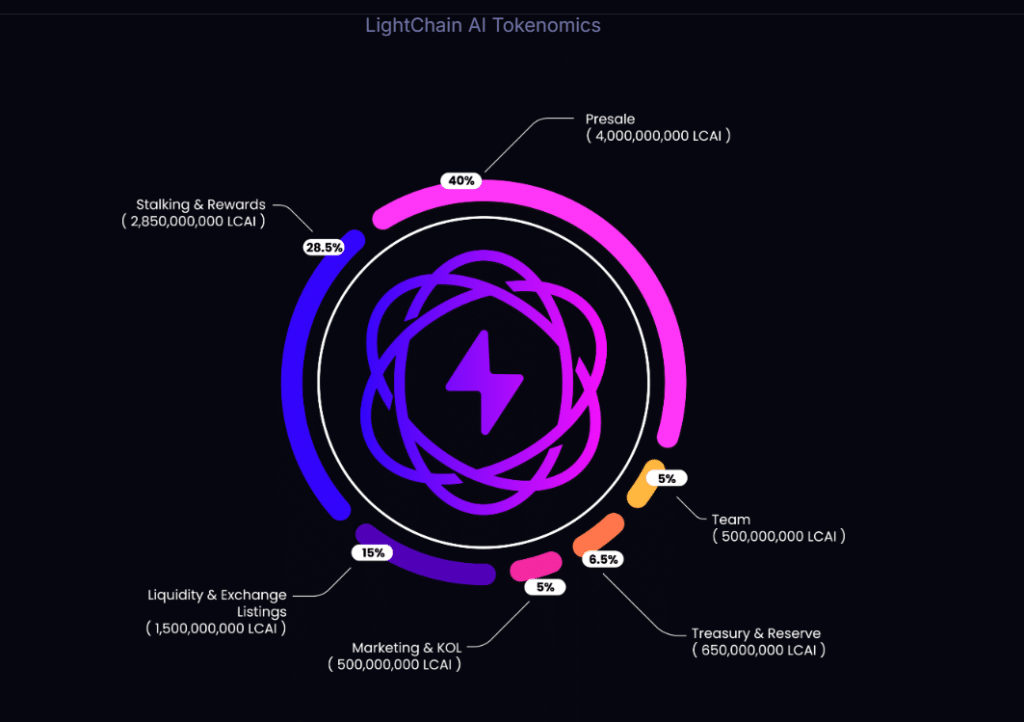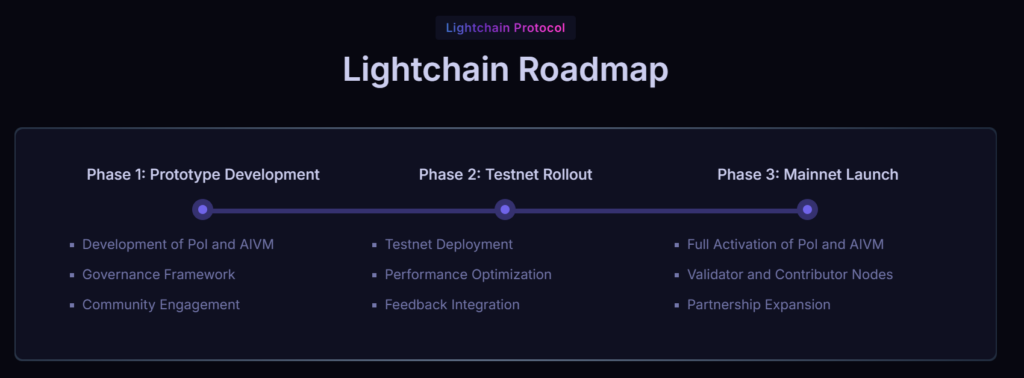Disclosure: This article does not constitute investment advice. The content and materials presented on this site are for educational purposes only.
Lightchain AI brings together blockchain and AI to address key challenges such as bias, scalability and transparency with its PoI consensus and AIVM.
Blockchain and AI are both phenomenal technologies, and the combination of these two holds the power to create impactful change in the world. But just as there are opportunities, there are also some obstacles on this intertwined path.
The first major problem is that most AI systems are centralized and cannot be trusted with sensitive information. There is certainly the possibility of data breaches and misuse. Second is the problem Bias. Most AI systems reflect the biases of their creators. A good example is how OpenAI’s ChatGPT responds to various policy questions. There is strong bias in most, if not all, major LLMs that exist today. For this reason, governance and coordination on the path forward of these models is important to maintain a free and open ecosystem that is not tied to VCs and governments.
Another problem is scalability. This problem seems to plague both AI and blockchain. And last but not least, there is a lack of transparency. In contrast to blockchain, this is often not the case with AI transparentwhich scares off technology enthusiasts.
However, there is a new project at the intersection of blockchain and AI that addresses all of these issues – Lightchain AI. Let’s evaluate this project to know more about its advantages and disadvantages.
overview
Website: Light Chain AI
Blockchain: Lightchain AI blockchain
Sector: AI and Blockchain
Token: LCAI
What is Lightchain AI?
Lightchain AI is a decentralized platform that integrates AI with blockchain. And that with the help of two programs. One of them is the Artificial Intelligence Virtual Machine (AIVM) and the second is Proof of Intelligence (PoI).
With the help of these two solutions, Lightchain AI aims to solve the scalability, privacy and trust issues that currently exist in the crypto blockchain space. It also strives to help eliminate bias through AI models and LLMs.
The Lightchain AI team states that the platform provides a fair, efficient, and privacy-preserving ecosystem for developers and participants. Let’s take a look at its features to see if these claims are true.
Features
Evidence of intelligence
Proof of Intelligence is a consensus mechanism designed to reward nodes for both providing resources to contribute to AI-intensive tasks and for solving blocks. How is it different from the popular Proof of Work or the environmentally conscious Proof of Stake? PoI provides incentives for contributions to AI development in the ecosystem.
How does it work? First, the participating nodes receive modular AI tasks according to their performance level. Tasks include activities such as training machine learning models or performing inference operations. Next, the nodes perform these tasks and create cryptographic evidence, such as: B. Zero-Knowledge Proofs (ZKPs).
The network then reviews these submissions based on metrics such as accuracy or efficiency. Once these are validated, nodes will be rewarded with Lightchain tokens.
This method offers a number of advantages. It is energy efficient, scalable and allows nodes of different sizes and power capacities to participate.
Virtual machine with artificial intelligence
According to the Light Chain AI In the white paper, the Artificial Intelligence Virtual Machine is a “specialized virtual machine that optimizes the execution of AI-specific tasks within the Lightchain AI ecosystem.”
Basically, it is a tool designed to handle complex AI tasks on the blockchain. This AI layer helps the AI integrate well with the blockchain so that the entire program works smoothly and effectively.
The AIVM also creates a secure and scalable environment for running AI models. This model even works with popular AI frameworks like TensorFlow and PyTorch. However, the most striking thing about this AI layer is that it can evolve through collaboration between developers.
In short, the artificial intelligence virtual machine works like the heart of the ecosystem, pumping lifeblood into all different parts of the system to ensure that everything is alive.
Tokenomics
The Lightchain token (LCAI) is the token of the Lightchain AI ecosystem. This token is primarily used for three main purposes: payment for AI tasks, staking for governance participation, and access to premium AIVM features.
Token distribution will be carefully planned to support growth and avoid centralization. The total supply of tokens will be distributed across different areas (see image below).
- 40% of the tokens (4 billion LCAI) are reserved for presales.
- 28.5% (2.85 billion LCAI) is earmarked for stakes and rewards.
- 15% (1.5 billion LCAI) is earmarked for liquidity and listings.
- 6.5% (LCAI 650 million) goes to the state treasury and the reserve.
- 5% (500 million LCAI) is allocated to the team.
- Another 5% (500 million LCAI) is dedicated to marketing and partnerships with key opinion leaders.

Lightchain AI also uses intelligent economic design. When it comes to controlling inflation, initial inflation rates fund early ecosystem growth but decline over time. The token burning mechanism is deflationary as part of the transaction fees and payments for AI tasks are burned. Pricing dynamically calculates gas fees for compute tasks based on task complexity and network load.
Roadmap
The Lightchain AI roadmap works in three key phases.

In Phase 1 (Prototype Development), the team focuses on building the Proof of Intelligence consensus and the artificial intelligence virtual machine. They also work on governance structures and community engagement.
In Phase 2 (Testnet Rollout), the team performs testnet deployment, performance tuning, and feedback gathering. The testnet will serve as a playground for developers who want to run bug bounties and other types of developer initiatives.
Finally, in Phase 3 (Mainnet launch), the team performs full activation of PoI and AIVM, using validator and contributor nodes. They are also looking to expand the partnership.
The team is currently in phase 1 of the roadmap.
pros and cons
With its real-world utility, deflationary tokenomics, and smart integration of AI into the blockchain, Lightchain AI undoubtedly has a whole host of advantages that will attract both developers and investors looking for the next big thing.
But are there any disadvantages? Although both AIVM and PoI are exceptional technological achievements, they appear to be overly complex.
Lightchain’s PoI is at the heart of the division of labor between nodes joining the network, from computational AI tasks to block solving. The AVIM is a decentralized autonomous organization similar to the EVM (Ethereum Virtual Machine). However, the AVIM is updated and reconciled based on the holder’s LCAI.
While PoW and PoS offer rewards to miners who either stake ETH or provide resources, PoI solves two problems: an upgradeable AIVM that is not static, and solves the centralization of the EVM by providing an AVIM that the token holders vote on upgrades .
Diploma
Lightchain AI is a blockchain ecosystem based on artificial intelligence. With intelligent solutions such as PoI Consensus and the Artificial Intelligence Virtual Machine (AIVM), the Lightchain AI team aims to create a fairer, more open and free AI model. The project is currently in pre-sales and is enjoying great popularity on both social media and mainstream media.
For more information about Lightchain AI, see Lightchain AI white paperget involved with the team XAnd telegramand look at it official website.
Disclosure: This content is provided by a third party. crypto.news does not endorse any product mentioned on this site. Users must conduct their own research before taking any Company-related actions.











Leave a Reply